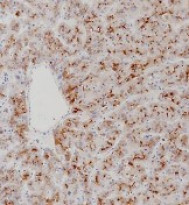ARG67035
anti-Glypican 3 antibody [SQab30329]
anti-Glypican 3 antibody [SQab30329] for IHC-Formalin-fixed paraffin-embedded sections and Human
Overview
| Product Description | Recombinant rabbit Monoclonal antibody [SQab30329] recognizes Glypican 3 |
|---|---|
| Tested Reactivity | Hu |
| Tested Application | IHC-P |
| Host | Rabbit |
| Clonality | Monoclonal |
| Clone | SQab30329 |
| Isotype | IgG |
| Target Name | Glypican 3 |
| Antigen Species | Human |
| Immunogen | Synthetic peptide of Human Glypican 3 |
| Conjugation | Un-conjugated |
| Protein Full Name | Glypican-3 |
| Alternate Names | GPC3, Glypican 3, OCI 5, SGBS1, SGBS, DGSX, SGB, Intestinal Protein OCI 5, Glypican Proteoglycan 3, Glypican 3, GTR2-2, MXR7, SDYS, Heparan Sulphate Proteoglycan, Secreted Glypican-3, OCI5 |
Application Instructions
| Application Suggestion |
|
||||
|---|---|---|---|---|---|
| Application Note | The dilutions indicate recommended starting dilutions and the optimal dilutions or concentrations should be determined by the scientist. | ||||
| Positive Control | Hepatocellular carcinoma |
Properties
| Form | Liquid |
|---|---|
| Purification | Purification with Protein A. |
| Buffer | PBS, 0.01% Sodium azide, 40% Glycerol and 0.05%BSA. |
| Preservative | 0.01% Sodium azide |
| Stabilizer | 40% Glycerol and 0.05%BSA |
| Storage Instruction | For continuous use, store undiluted antibody at 2-8°C for up to a week. For long-term storage, aliquot and store at -20°C or below. Storage in frost free freezers is not recommended. Avoid repeated freeze/thaw cycles. Suggest spin the vial prior to opening. The antibody solution should be gently mixed before use. |
| Note | For laboratory research only, not for drug, diagnostic or other use. |
Bioinformation
| Database Links | |
|---|---|
| Gene Symbol | GPC3 |
| Gene Full Name | Glypican 3 |
| Background | Cell surface heparan sulfate proteoglycans are composed of a membrane-associated protein core substituted with a variable number of heparan sulfate chains. Members of the glypican-related integral membrane proteoglycan family (GRIPS) contain a core protein anchored to the cytoplasmic membrane via a glycosyl phosphatidylinositol linkage. These proteins may play a role in the control of cell division and growth regulation. The protein encoded by this gene can bind to and inhibit the dipeptidyl peptidase activity of CD26, and it can induce apoptosis in certain cell types. Deletion mutations in this gene are associated with Simpson-Golabi-Behmel syndrome, also known as Simpson dysmorphia syndrome. Alternative splicing results in multiple transcript variants. [provided by RefSeq, Sep 2009] |
| Function | Binds to CD81 which decreases the availability of free CD81 for binding to the transcriptional repressor HHEX, resulting in nuclear translocation of HHEX and transcriptional repression.Inhibits the dipeptidyl peptidase activity of DPP4. [UniProt] |
| Cellular Localization | Cell membrane, Membrane |
| Calculated MW | 66 kDa |
| PTM | This processing is essential for its role in inhibition of hedgehog signaling. A second proteolytic event may result in cleavage of the protein on the cell surface, separating it from the GPI-anchor and leading to its shedding from the cell surface. [UniProt] |
Images (1) Click the Picture to Zoom In






